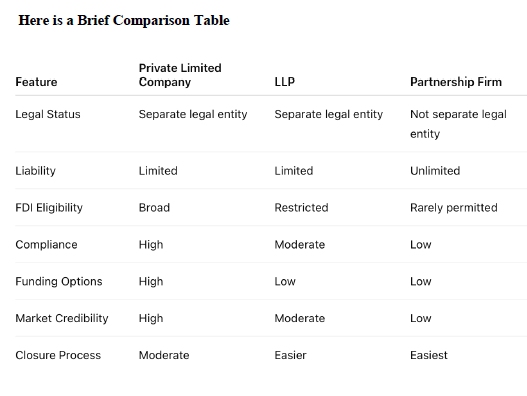- within Corporate/Commercial Law topic(s)
- with readers working within the Law Firm industries
- within Corporate/Commercial Law topic(s)
- with readers working within the Technology industries
Introduction For foreign companies looking to establish a presence in India, one of the earliest and most important decisions is choosing the right business structure. Your choice impacts liability, compliance obligations, taxation, funding potential, and even how your business is perceived in the market.
Below is a detailed FAQ guide to help you compare three common structures: Private Limited Company (PLC), Limited Liability Partnership (LLP), and Partnership Firm.
1. What is the basic nature of each structure?
- Private Limited Company (PLC) – A separate legal entity incorporated under the Companies Act, 2013. It can have a mix of resident and non-resident shareholders.
- Limited Liability Partnership (LLP) – A hybrid structure under the LLP Act, 2008 combining features of a partnership and a company, offering limited liability to partners.
- Partnership Firm – A simple business arrangement registered under the Partnership Act, even unregistered in some cases), where partners share profits and liabilities.
2. What are the ownership and management requirements?
- PLC – Minimum 2 shareholders and 2 directors (at least 1 must be an Indian resident).
- LLP – Minimum 2 partners (at least 1 must be a resident designated partner).
- Partnership Firm – Minimum 2 partners; no residency requirement under the Act, but FDI restrictions apply.
3. What is the liability exposure?
- PLC – Shareholders' liability is limited to their shareholding.
- LLP – Partners' liability is limited to their capital contribution.
- Partnership Firm – Partners have unlimited liability; personal assets can be used to settle business debts.
4. What are the compliance and reporting requirements?
- PLC – Annual financial statements, board meetings, statutory audits, and ROC filings.
- LLP – Annual statement of accounts and solvency, LLP annual return, audit if turnover exceeds prescribed limits.
- Partnership Firm – Minimal compliance, mostly tax filings; no annual ROC reporting.
5. How are these structures taxed?
- PLC – Corporate tax rates apply (22% for domestic companies without incentives; concessional rates for certain conditions).
- LLP – Flat 30% income tax + applicable surcharge and cess; no dividend distribution tax.
- Partnership Firm – Flat 30% income tax; profits taxed at firm level, then exempt in partners' hands.
6. Which structure is better for raising capital?
- PLC – Most investor-friendly; allows issue of equity, preference shares, and convertible instruments.
- LLP – Not generally preferred by institutional investors; no shareholding structure.
- Partnership Firm – Difficult to raise institutional funding; limited to partner contributions or loans.
7. What are the FDI (Foreign Direct Investment) rules?
- PLC – FDI permitted under the automatic route in most sectors, subject to sectoral caps.
- LLP – FDI permitted in sectors where 100% FDI is allowed under the automatic route and no performance-linked conditions apply.
- Partnership Firm – FDI generally not permitted; requires government approval.
8. What is the ease of exit or closure?
- PLC – Formal winding-up or strike-off process with ROC.
- LLP – Voluntary winding-up or strike-off with ROC; relatively simpler than a PLC.
- Partnership Firm – Dissolution is easier; governed by partnership agreement.
9. Which structure suits which kind of foreign entrant?
- PLC – Best for those seeking scalability, brand credibility, and investor interest.
- LLP – Good for smaller ventures, joint service delivery, or consulting operations.
- Partnership Firm – Rarely chosen by foreign investors; suited for very small, low-risk setups.

Pro Tip:
Many clients start with an LLP for flexibility and then convert to a PLC when scaling or attracting investors. The right starting point depends on your sector, funding strategy, and operational goals—something a structured feasibility analysis can clarify. The decision should consider long-term growth plans, regulatory environment, funding needs, and operational complexity. Professional advice is recommended to ensure compliance with Indian laws.
If you're still deciding whether to set up an entity at all, you may find our other articles also interesting.
How we help at R. Arora & Associates
Our India entry team works with foreign founders to:
- Assess sector-specific FDI rules and eligibility.
- Model tax and compliance costs for each structure over a 3–5 year horizon.
- Manage incorporation end-to-end, including director/partner onboarding, bank account opening, and statutory registrations.
- Integrate accounting, HR, and compliance support so that your India operations stay fully compliant without juggling multiple service providers.
The content of this article is intended to provide a general guide to the subject matter. Specialist advice should be sought about your specific circumstances.


